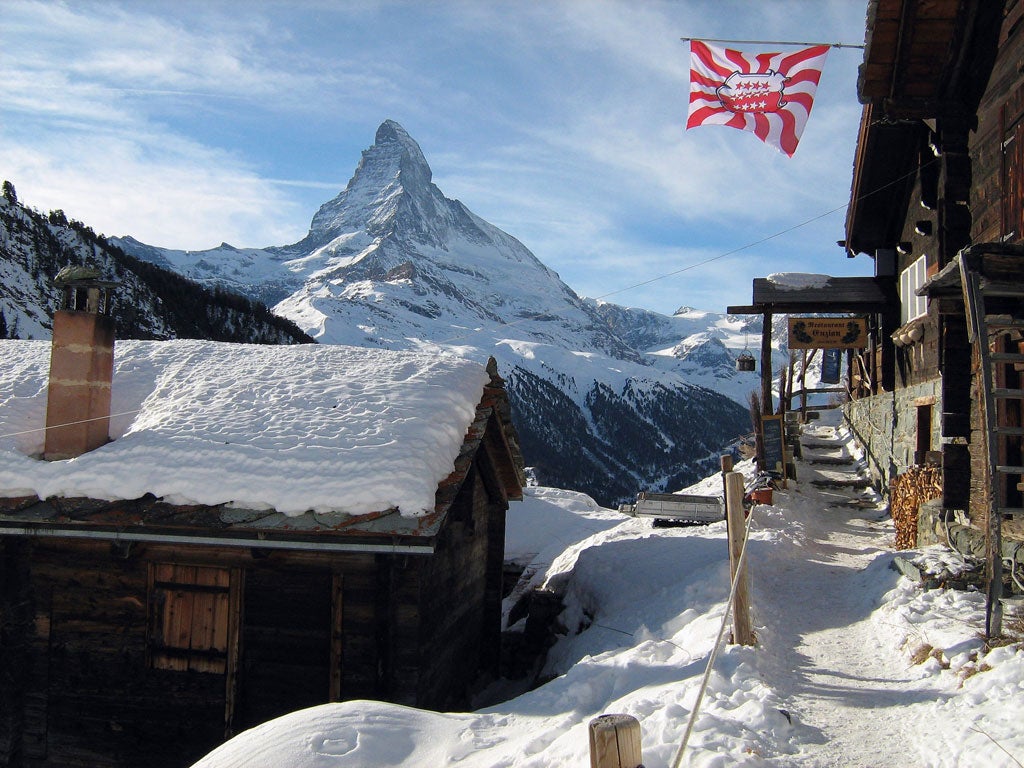
Your support helps us to tell the story
From reproductive rights to climate change to Big Tech, The Independent is on the ground when the story is developing. Whether it's investigating the financials of Elon Musk's pro-Trump PAC or producing our latest documentary, 'The A Word', which shines a light on the American women fighting for reproductive rights, we know how important it is to parse out the facts from the messaging.
At such a critical moment in US history, we need reporters on the ground. Your donation allows us to keep sending journalists to speak to both sides of the story.
The Independent is trusted by Americans across the entire political spectrum. And unlike many other quality news outlets, we choose not to lock Americans out of our reporting and analysis with paywalls. We believe quality journalism should be available to everyone, paid for by those who can afford it.
Your support makes all the difference.This stretch of Swiss narrow-gauge rail rambles through meadows and over mountain passes, skirts stone castles, gingerbread villages and the Matterhorn, and rumbles over 291 bridges and through 91 tunnels. It's one of most beautiful rail journeys on Earth.
It might not be as long as the Trans-Siberian, but this classic rail journey makes up for it with a vertical spectacle of stunning proportions. Switzerland has several mountain rail trips, but it is the Glacier Express, which runs northeast from Zermatt to St Moritz, that is the most mythical.
As Switzerland's Alpine resorts became popular with Europe's rich and famous in the early 20th century, the idea for a train linking Zermatt and St Moritz grew. In 1930, the inaugural steam-train journey between the two Alpine resorts took place and the seven-and-a-half-hour trip hasn't lost its appeal since.
Starting in Zermatt, the gateway to the Matterhorn, the train winds slowly north down a valley to Brig. From here it swings northeast along the pretty eastern stretch of the Rhône valley towards the Furka Pass (which it circumvents by tunnel) and descends on Andermatt before again climbing up to the Oberalp Pass, the literal high point of the trip at 2,044m. From there it meanders alongside the Vorderrhein River, passing through Disentis/Mustér before arriving in Chur. The main train continues to St Moritz, which has been luring royals, the filthy rich and moneyed wannabes since 1864.
The railway endured the first few years of the Second World War, but was eventually suspended from 1943 to 1946. It was a seasonal train for the first 50 years because of heavy snow and high avalanche risk. In fact, each autumn the train's overhead contact wires between Oberwald and Realp were removed and the Steffenbach bridge was dismantled, only to be reassembled in spring. Once the Furka Tunnel was blasted and completed in 1982, the train was able to run year round and it remains at its most spectacular during winter.
THE JOURNEY TODAY
You'll board the train in Zermatt, which has starred among Switzerland's glitziest resorts since the 19th century. Today it attracts intrepid mountaineers and hikers, skiers who cruise at a snail's pace, spellbound by the scenery, and style-conscious darlings flashing designer togs in the lounge bars. All are smitten with the Matterhorn, an unfathomable monolith you can't quite stop looking at. Like a shark's fin, it rises above the town; like an egotistical celebrity it squeezes into every snapshot; like a diva it has moods swinging from pretty and pink to dark and mysterious.
Close to the Italian border and bisected by the Rhône and Saltina rivers, Brig has been an important crossroads since Roman times. It's here you start to notice the cultural diversity of the Glacier Express, as Italian becomes increasingly audible among the otherwise German-dominated chatter in the coach.
The train continues along the Rhône through the Furka Tunnel before descending into Andermatt, a lovely valley village surrounded by mountains.
Considered to be the demarcation point between northern and southern Switzerland, it's accessible by four mountain passes. The eavesdropping twists back from Italian and German into a touch of Romansch, as the rail rises to the wind-chilled Oberalp Pass, the train's highest point and a pass that separates Graubünden from Uri.
Soon the Vorderrhein River appears by the tracks, and you'll follow it into Chur, Switzerland's oldest city. Here you can saunter the cobblestone lanes of the Old Town, dotted with frescoed 16th-century façades, gurgling fountains and lofty towers before boarding once more and rolling into St Moritz, Switzerland's original winter wonderland and the cradle of Alpine tourism.
With its perfect lake and lofty mountains, the town looks a million dollars. Yet despite the Gucci set propping up the bars and celebs on the pistes, this resort isn't all show. The real riches lie outdoors with superb carving on Corviglia, hairy black runs on Diavolezza, and miles of hiking trails.
Extract taken from 'Great Journeys', published by Lonely Planet (£29.99). Readers can buy a copy for £25 including UK P&P by going to shop.lonelyplanet.com and using the code INDEPENDENT
The Glacier Express
Distance: 275km
Countries covered: Switzerland
Ideal time commitment: One to two days
Best time of year: December to April
Essential tip: Take the eastbound train; it's usually less crowded. Book in advance if you are heading west from St Moritz.
Essential experiences
* Watching, awe-struck, as the shark-fin Matterhorn peak soars above Zermatt, signifying the beginning of a spectacular journey.
* Descending from the snow country into jade valleys where the turquoise Rhône boils over boulders and offers a soothing brand of topographical diversity.
* Exploring the Goms, and larger towns such as Andermatt, surrounded by mountains and retaining that Alpine village feel. You're in chalet country now.
* Wandering along the 16th-century cobblestone lanes, past frescoed façades in old Chur.
* Surrendering to the beautiful bling and luscious powdery slopes of opulent, arrogant, yet still seductive St Moritz.
Join our commenting forum
Join thought-provoking conversations, follow other Independent readers and see their replies
Comments